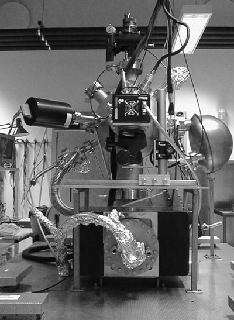High Resolution Core-level Photoemission Spectroscopy (SuperESCA)
Elettra Sincrotrone Trieste

Electron Spectroscopy for Chemical Analysis (ESCA), also called X-ray photoelectron spectroscopy (XPS), is a surface-sensitive quantitative spectroscopic technique that measures elemental composition in the parts per thousand range. In ESCA microscopy, the X-ray emitted photo electrons are detected and analyzed in terms of their kinetic energy. Small shifts in the element specific core or valence energies signal changes and can give detailed information about bond bindings. ESCA is a method sensitive to chemical information of a few monolayers and therefore offers a specific instrument for surface sensitive chemical analysis of heterogeneous materials.
Super ESCA combines high resolution capabilities with the high flux of linearly polarized photons in the 90 to 1500 eV range. It is therefore also possible to obtain high resolution spectra for low-density systems (such as thin films or supported nanoparticles) and follow their evolution in real-time, e.g. during functionalization processes or surface reactions.
Contact: Silvano Lizzit
Tel: +39 040 375 8027 (office) | +39 040 375 8342 (beamline)
Technical specifications
The 98 periods undulator consists of two equal modules which produce horizontally polarised light. By setting the gap value from a minimum of 13.5 mm up to 40 mm the photon energy can be varied in the range 90÷1500 or 130÷1800 eV when the Elettra storage ring works at 2.0 or 2.4 GeV, respectively.
The insertion device is characterized by a maximum brilliance of 4.36×1018 ph/s/100 mA/0.1% BW/mm2/mrad2.
Sample environment
The Super ESCA end-station consists of two Ultra High Vacumm (UHV) chambers separated by a gate valve. The smaller chamber is designed for sample preparation. A VG sputter gun (ion beam energy 0.1÷3 keV) and a gas line allow for standard cleaning procedures. The chamber is also equipped with a plasma source for, e.g., sample functionalization. The main chamber is made of μ-metal for optimum shielding, avoiding in this way the influence of magnetic fields that could distort the experimental results. It is equipped with a 150 mm hemispherical electron energy analyser with variable entrance slit, and a delay line detector developed at Elettra. A Low Energy Electron Diffraction (LEED) system, UV lamp, monochromatized electron gun, gas inlet system and mass spectrometer are also available.
Detailed information can be found on the beamline’s main homepage.



